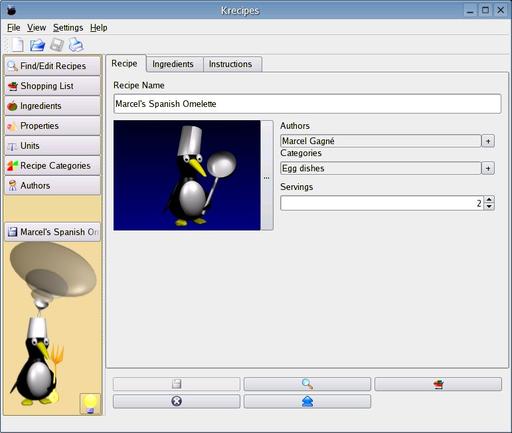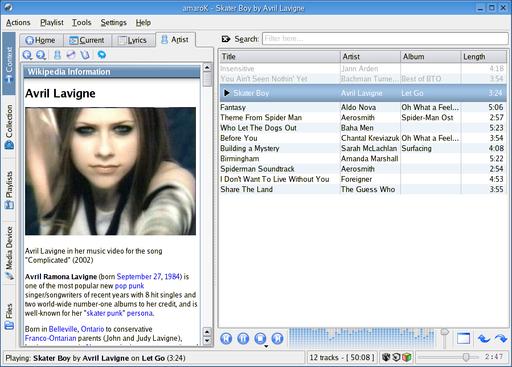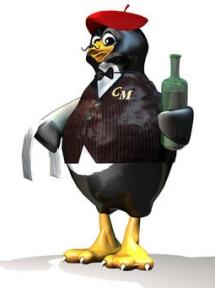

The December 2006 Cooking with Linux marks seven years of Chez Marcel, its Linux Chef and François, his famous waiter. For this occasion, Marcel has invited some regular readers of the column to share their favorite issues and, of course, a glass or two (or three, or four) of wine.
Seven years, mon ami. Yes, François, it does seem to have gone by very quickly. We'll have plenty of time to reminisce when our guests arrive. Ah, but they are already here! Welcome, mes amis to Chez Marcel, where you'll find one of the world's largest wine cellars and the finest in Linux and open-source software. Please sit and make yourselves comfortable. I'll have François fetch the wine right away.
Quoi? Incroyable! It appears that my faithful waiter decided to beat me to the punch when it came to tonight's wine selection. He has already chosen the wine and brought it up from the cellar. Since this is a penguin-studded magazine, he has chosen one of my favorite, not to mention inexpensive, Australian wines. It's called Little Penguin. Of course, my judgment may be clouded by the name of the winery, but the choice seems fitting. François, please serve the Little Penguin wine for our guests. Today, we have both a Chardonnay and a Shiraz (for those who prefer red).
Those of you who have been following this column from the beginning may already be aware that this December 2006 issue marks seven years of my Cooking with Linux. The first of these columns, however, was a kind of experiment, featured in the September 1999 special issue. The regular series began a few months later, with the January 2000 issue. To commemorate, the folks at Linux Journal suggested I select a few of my favorite columns for this issue. When I thought about this idea, I decided that the best arbiters were the readers, and so I've invited a number of special guests here tonight to tell us what they liked, and why.
Let's start with table seven, where Troy Banther is waving his hand madly. “One of my favorites is 'If Only You Could Restore Wine' in the June 2006 issue of the magazine. Knowing what programs are out there in the Linux world and having a how-to on backing up and restoring is great. I'm extremely partial to KDar since I use the KDE window manager.”
Jon Biddell, at table 15, agrees with Troy Banther. “I think my favorite would have been the June 2006 article on backups—something I don't do anywhere near as often as I need to....”
Over at table three, Colleen Beamer says she doesn't know if she can pick just one. She tends to lean toward the August 2004 issue because “this column introduced me to Krecipes [Figure 2], and I went from there to have my first true open-source involvement by writing the Krecipes Handbook. 'Crossing Platforms', in the May 2005 issue, introduced me to my still favourite Linux game, Blobwars. However, if I have to pick one column, the one in the September 2005 issue, 'Wireless Tools', has helped me the most. Without it, I probably wouldn't have been able to know what to do to get wireless installed and working on my laptop.”

Figure 2. Krecipes as it appeared in August 2004. The package will likely reach its 1.0 release when this issue is released.
When Daniel Gagnon, who is sipping his wine at table 27, was asked about his favorite, he replied, “The one about Tellico [Figure 3], in the April 2005 column titled, 'The Cook's Collection'. Why? Simply because people are always borrowing my books.”
He adds, “En passant, un article sur le caractère multilingue de Linux pourrais être int éressant, n'est-ce pas?”
All right, Daniel, I'll just take care of that request right now. In KDE, fire up the KDE Control Center (command name, kcontrol) and click on Regional & Accessibility. Under that category, select Keyboard Layouts. Usually, the only layout visible to the right in the main window (under Active Layouts) is whatever you chose during installation. On mine, it says, “U.S. English”. Now, I like having access to a quick keyboard switch so that I can use things like the é at the end of my last name. These are included in the Canadian layout. I also can get them using the “U.S. English w/deadkeys” layout. So, I select it from the Available Layouts section, then click the Add button (Figure 4).
If you want more, add them now as well. Then, click Apply. A small flag icon appears in the system tray of your kicker panel, over on the right. Click the icon to switch from one layout to the other. If you are using OpenOffice.org, you now can type the characters you want without doing an “Insert Special Character” operation each time. If you find yourself having problems with those characters displaying properly in OpenOffice.org, this is usually a problem due to using incorrect or incompatible fonts. For example, someone sends you a document with a Microsoft font and you don't have it installed. The resulting text, particularly if you are entering special characters, can then look a bit strange. All that's needed is to add those fonts using the spadmin program (OpenOffice.org's printer administration program, which also lets you add fonts). I hope that helps you out, Daniel.
François, our guests' glasses are looking a little low. If you would be so kind as to visit everyone and indulge each guest with his or her choice of wine. While you do so, we'll check in with John Kerr, over at table 12. He says, “I must admit that finding a favorite column would be difficult as there are so many good ones to choose from. My favorite column, however, is the August 2005, 'Ultimate in Small Linux' article. This column demonstrates two mini-distros (Damn Small Linux and Puppy Linux) as well as the unique ways they can be used—live CD, disk install or USB key [Figure 5]. These distros also can be used to revive older equipment. This only emphasizes the diversity of our favorite operating system.”
Choosing a favorite was also a bit difficult for David Knickmeyer, sitting over at table 19. He says, “I'd probably go with the Xnest article [Figure 6], 'Can't Get Enough Desktops', in the March 2004 issue. I admit it, I'm an eye-candy junkie. GNOME, Enlightenment, Window Maker—I've tried them all, often. I keep coming back to KDE and SuperKaramba, but the nested X servers let me play around and still be productive—well....”
I see another hand waving over at table eight, and it's Lew Pitcher. “My list runs around 20 articles so far, and I've covered only about half of my LJ back issues. So, you can imagine the difficulty I have in picking one column. But, pick one I have. I take you back to February 2002, to a column entitled 'Observe, Mon Cher Ami', in which you introduced us to xawtv and video conferencing in general. In that column, François finally got a face (even though it was a stuffed toy avatar), and he met a mystery woman, who shall go nameless, but might be known as Sally in other places [Figure 7]. Of course, my second-favorite column would be from December 2004, 'Lights...Camera...Action!', in which we find the tools to do video podcasts among the various bits and pieces of our toolboxes. Who knew that a cheap microphone and a just-as-cheap Webcam could make you a video star?”

Figure 7. Video conferencing with VIC—who is this mysterious woman, chatting with our François?
Over at table 32, Johann Schmidt has this to say, “My nomination for favorite Cooking with Linux column is fairly recent—from the December 2005 issue, 'amaroKing the Night Away'. I had not heard of Amarok before [Figure 8], and your introduction to it was fantastic. I installed it at home the day I received the issue at work, and after only a slight bit of dependence-finding, I had an awesome music system/library/jukebox. It works with our iPods too! I have been getting my children more and more exposed to Linux—and because Amarok doesn't crash like iTunes does on that proprietary x86 OS, they have yet another reason to be open-source kids.”

Figure 8. Amarok, one of the best music players out there, just keeps on getting better all the time.
Bert Sutherland has this to say, “My favorite choice by far is your November 2004 'Illuminating Your Network's Darkest Corners'. I had been a Linux Journal subscriber for only a few months when this issue came out, and it is still one of the best articles I've read. When I sit down to read Cooking with Linux, I know I am in for a surprise and that you will be serving up another selection (of wine and Linux tidbits of information) that I was previously not aware existed. This was the case with the programs mentioned in your network article, and to this day IPTraf [Figure 9] is one of the first programs I install when working with a new machine.”
Margaret Wendall, sitting over at table 14, also is interested in security: “It's become apparent to me and one of my clients (I help with his Web pages) that people are stealing my photos and using them to advertise on their pages. I think your good instructions on steganography, back in the January 2005 article 'Forgotten Security', are going to be a better solution than something like Digimark, because only two or three people will even know the photos are encrypted. This is not only fun, but very practical.” Was I a spy in a past life?

Figure 10. Using the Steghide program, a rather large order of wine is hidden and encrypted within this portrait of François.
François, how did you manage to sneak in that portrait of yourself? You truly are efficient today, mon ami. I see that you have continued to refresh our guests' glasses. Excellent. Sadly, it seems that closing time is upon us, so the next refill will have to be the last one. My sincere thanks to everyone out there for joining me here every month these past seven years and for helping make Cooking with Linux as much fun as it has been. I also want to thank the members of my own WFTL-LUG, aka “The Lug Nuts” (new members welcome), who joined me in the restaurant today. For a complete list of past Cooking with Linux columns and links to each article on-line, check out www.marcelgagne.com/ljcooking.html. Now that François has so graciously refilled your glasses, please join me in a toast and let us all drink to one another's health. A votre santé Bon appétit!
Resources for this article: /article/9379.